Sometimes in life you see something and say, “Wait a minute, is that real?” And then you take a closer look and yep, it is!
Well, that is how you might look at an Alocasia plant the first time you see one. They are some of the most beautiful and eye catching plants around with it’s stunning large leaves.
Alocasia genus plants often go by the common name Elephant Ears. There are more than 79 different Alocasia varieties, and they’re mainly native to tropical and subtropical regions of the world, such as Asia and eastern Australia. They also go by the common name of African Masks.

Elephant’s Ear is a popular plant that many people around the world love. Today, they are also commonly grown outdoors in the southern regions of the United States in regions that boast tropical or humid environments perfect for this plant. They’re also widely grown indoors all over!
These beautiful tropical plants can grow up to 2 to 15 feet in height, and 2 to 8 feet in width! It is an incredibly large plant, and blooms best during the spring and the summertime. While not all of these species will bloom, the common flower colors are light butter or yellow.
Alocasia plants are toxic so be sure to keep them away from pets and small children!
Table of Contents
21 Types of Alocasia Plants
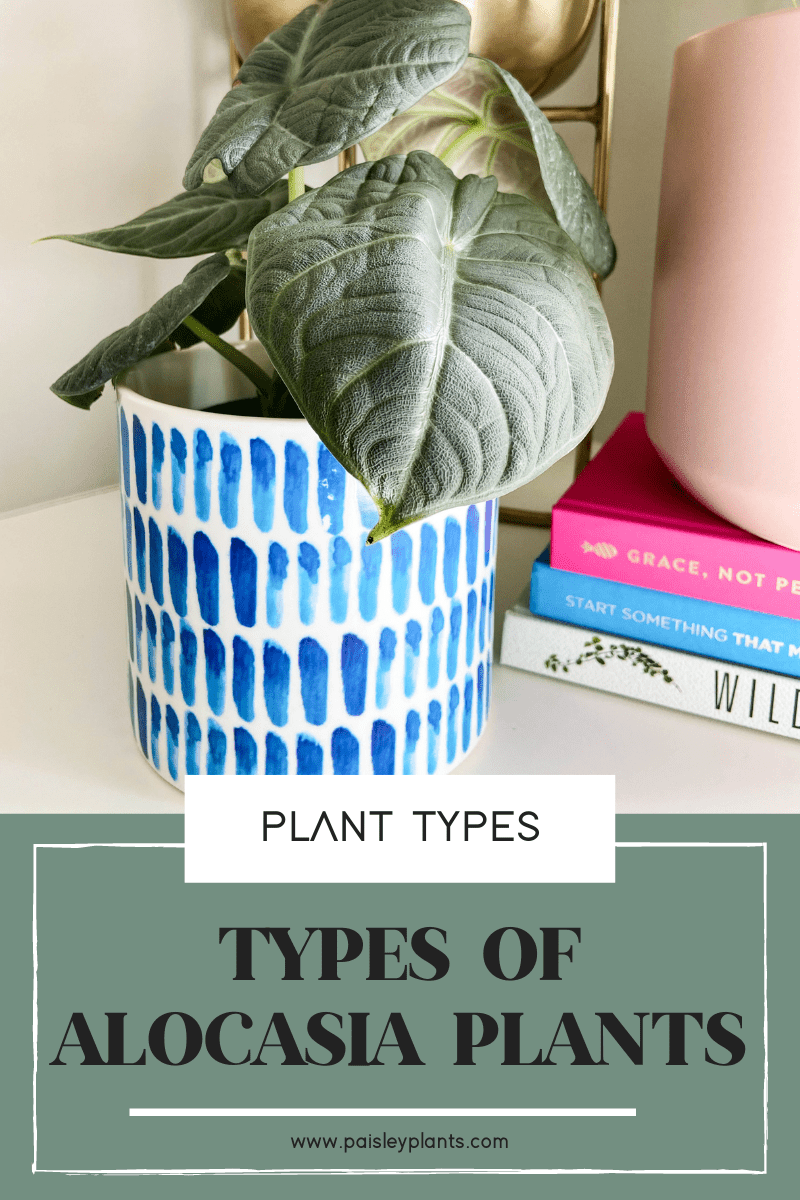
This post includes affiliate links.
Today, I am going to walk you through several of the varieties of Alocasias that are out there.
Here we go!
1. Alocasia Reginula ‘Black Velvet’
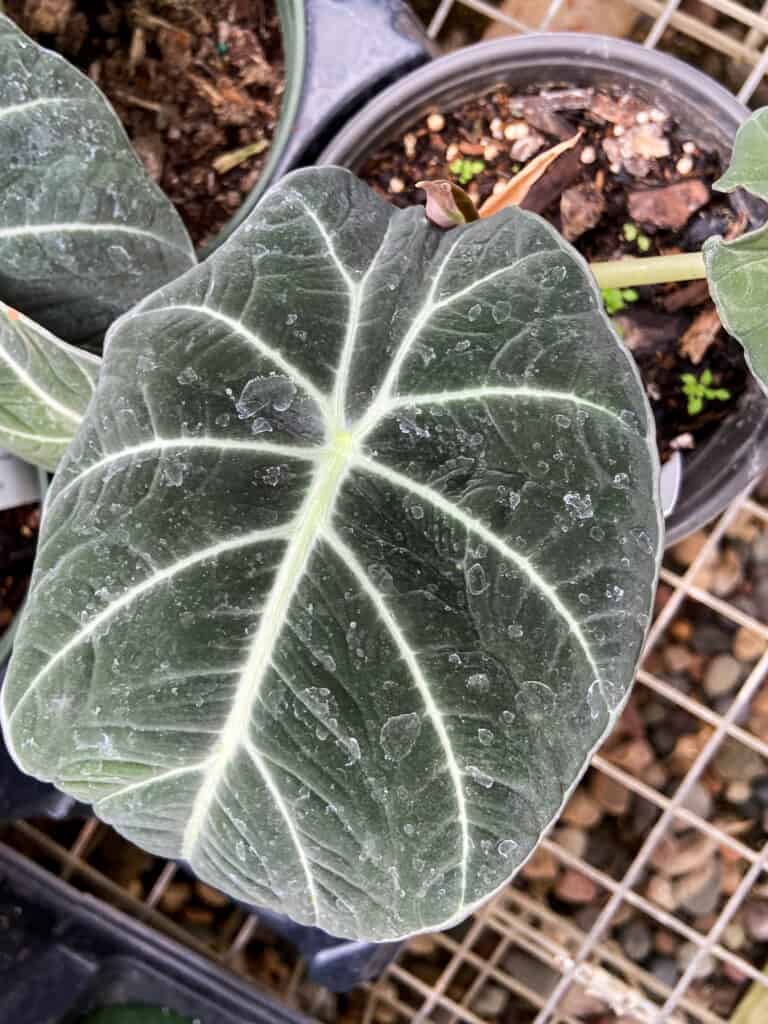
This beauty is also sometimes referred to as ‘Little Queen.’ It has an exotic look with silver veins on the leaves that shine against the broad leaf’s dark, velvety background.
It is native to Southeast Asia and grows on the jungle floors in its native habitat. Prior to the magic of tissue culture, this plant was quite rare, but is now becoming more available to purchase.
This plant grows best in bright indirect light. They need more humidity than other plants, but require less as far as soil moisture goes. Be sure to not overwater so that you don’t get root rot.
Find more about Alocasia Black Velvet here!
2. Alocasia Infernalis ‘Black Magic’

Image via Sunshine Greens
These plants are known for the metallic purple leaves of their seedlings and juvenile plants. They are also known for the deep purple/black leaves of mature plants.
It is known as one of the four rarest Alocasias. It has come to be well known as being a rare collector’s plant. You may want to consider this as a gift for a friend or a loved one because of this!
You should place your plant in a north, east, west window for optimum growth. However, don’t place it in an area with strong sunlight that lasts for more than three hours a day because this may cause the plant to develop a washed out appearance with brown patches.
3. Alocasia Rugosa ‘Melo’
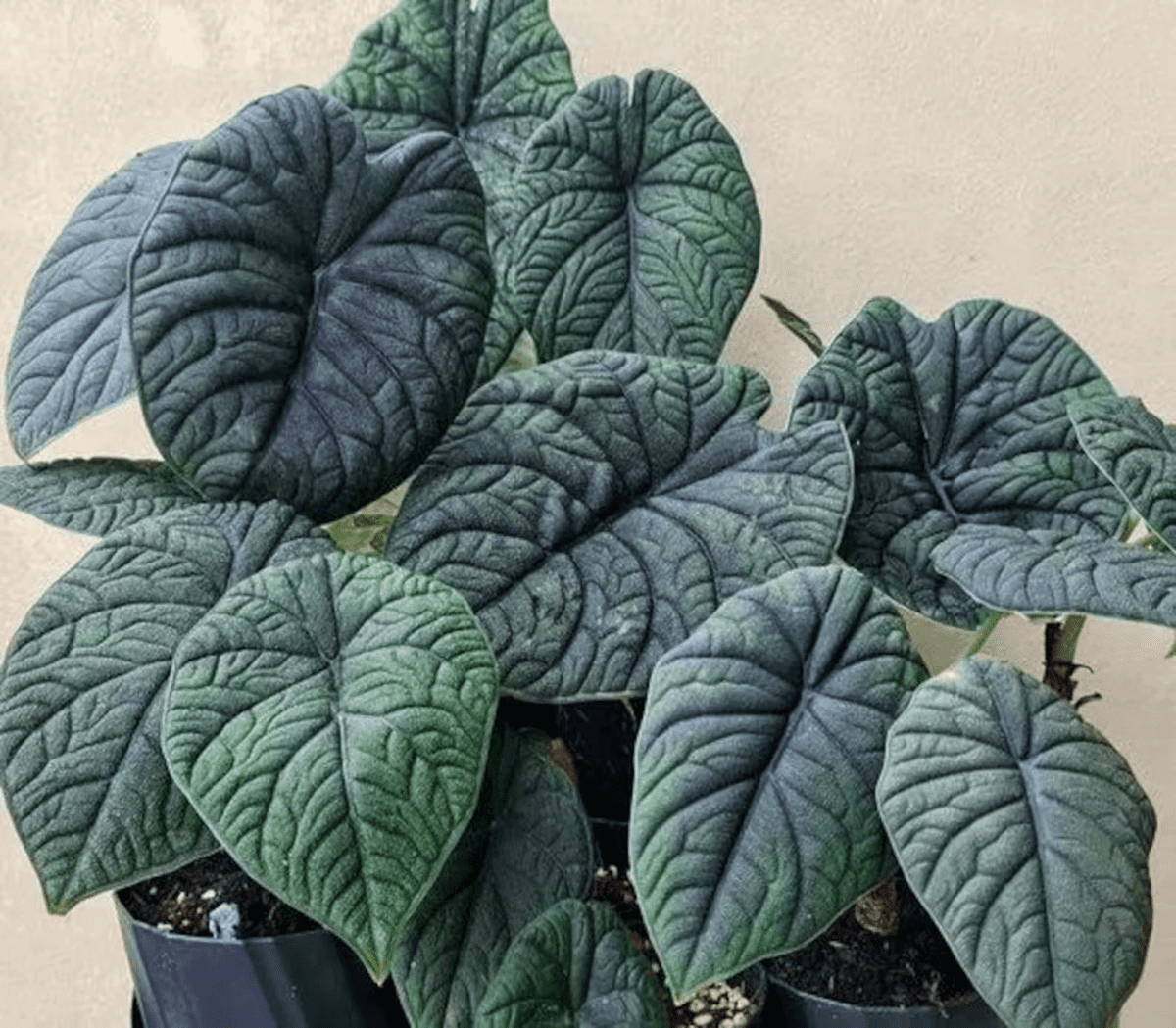
Image via Sunshine Greens
The leaves on this plant are very tough, yet very delicate! These have the thickest and most heavily textured leaves of all the Alocasia plants! The sun can scorch them easily, so be careful to not place them in direct sunlight.
These plants love humidity also. An ideal humidity for them is 75% during the daylight hours and about 95% – 100% at night. If you can keep the humidity this high, that would be best. If not, the use of a humidifier would help out greatly!
The Alocasia Rugosa ‘Melo’ is sometimes confused with artificial plants due to the thick foliage. They have jade-green leaves with silverish-green veins.
4. Alocasia Zebrina

Image via Sunshine Greens
These are native to the rainforest and require lots of humidity to flourish properly. You could place one of these plants in your bathroom to ensure it gets enough humidity if your house is too dry!
It has been exclusively found on a single island in the Philippines, so considered somewhat rare. This plant is also very toxic to both humans and pets, so be sure to keep them away from small children and animals.
Watering once a week should be sufficient since they prefer slightly wet soil. They are prone to root rot, however, so don’t overwater. It is preferable to soak the plant gently when watering and let the water drain down until it falls out the bottom of the pot.
5. Alocasia Zebrina ‘Reticulata’
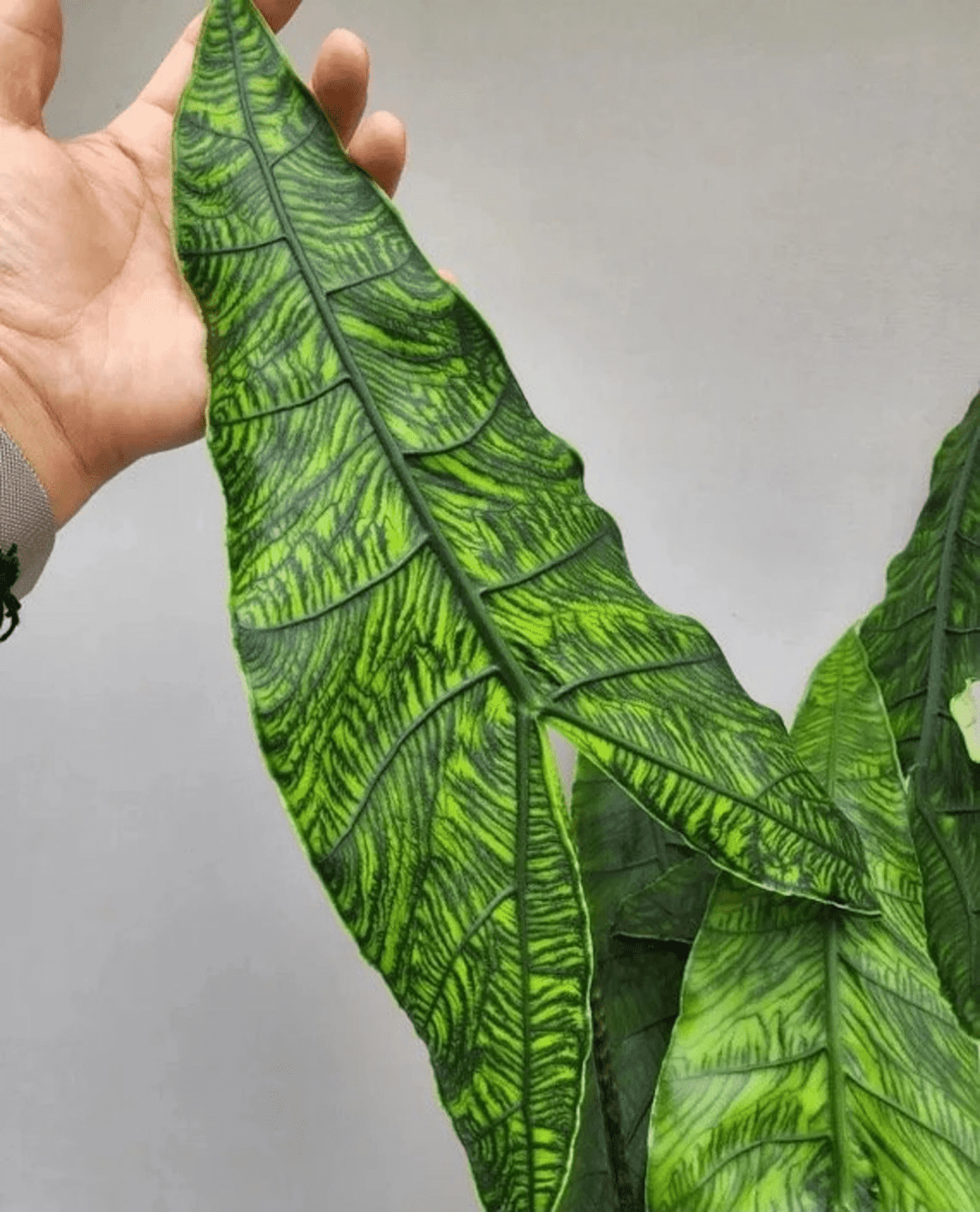
Image via Sunshine Greens
The Alocasia Zebrina ‘Reticulata’ has very narrow arrowhead shaped leaves. They are dark green with an odd coloration effect commonly called reticulated. They are very unique, to say the least!
There is not much known about the origins of this particular Alocasia. It is considered extremely rare and seldom seen in the wild. Why not have one of these in your collection for a conversation starter, huh?
Frequent misting is highly recommended along with keeping the soil moist, but not wet. Allow the top two to three inches of the soil to dry out between waterings to prevent overwatering and root rot.
6. Alocasia Macrorrhiza ‘Stingray’ & ‘Baby Ray’
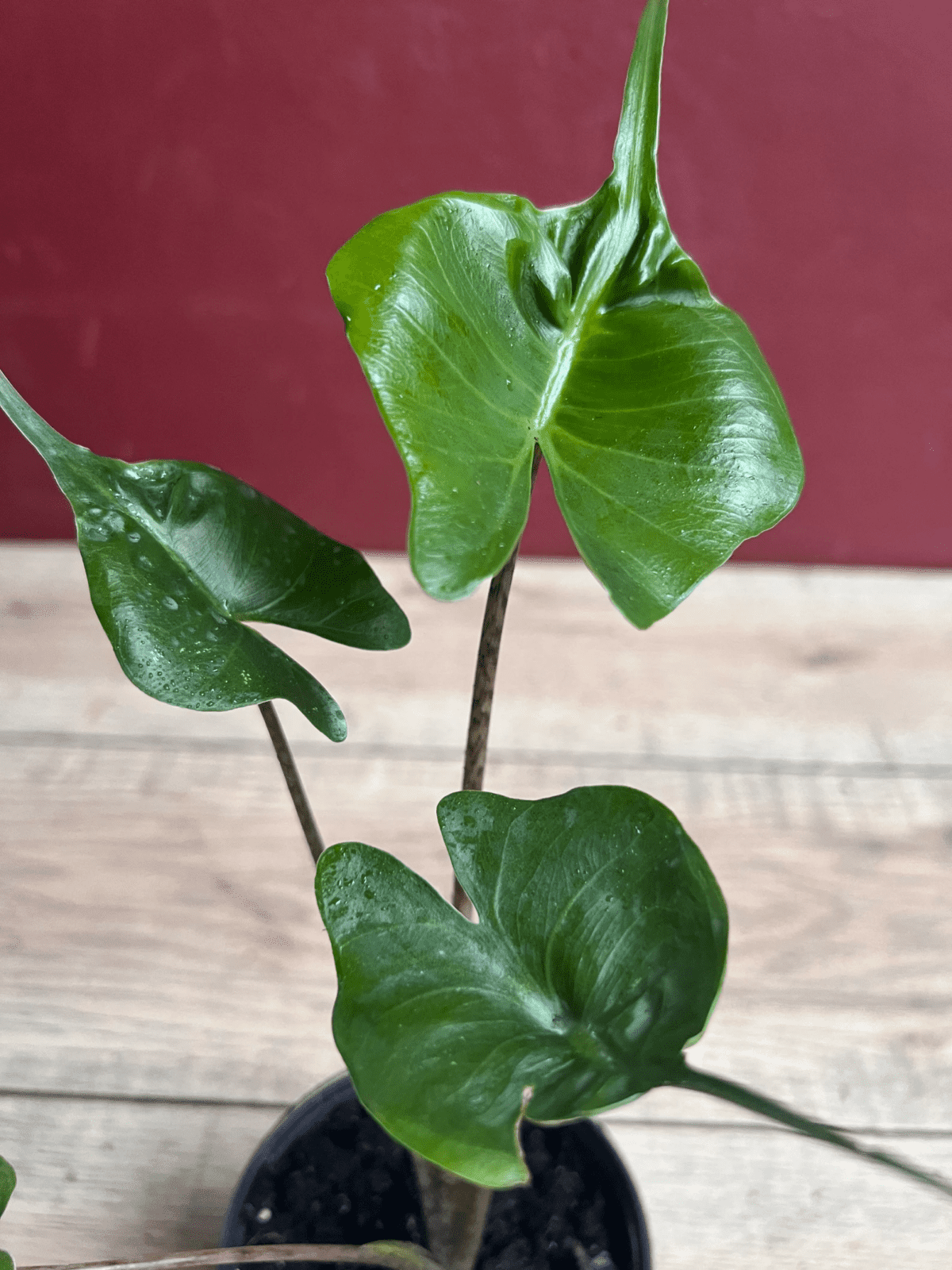
Image via The Nodes
These ‘Stingray’ plants have leaves that look like a stingray! There is a long, pointy spear-like protrusion at the end of the leaves that totally looks like a real stingray! The leaves tend to curl inward at the largest part, but the stinger will typically stand straight upward!
These plants need to have a consistent watering schedule. You should also be sure to dust the leaves of the plants regularly so that photosynthesis can take place and ensure proper growth for the plant.
Not much is known about the origins of the Stingray Alocasia. Some botanists believe it to be a hybrid while others lean towards the idea of it being a naturally occurring cultivar. Who knows, but it sure is a cool looking plant!
7. Alocasia Cuprea ‘Red Secret’
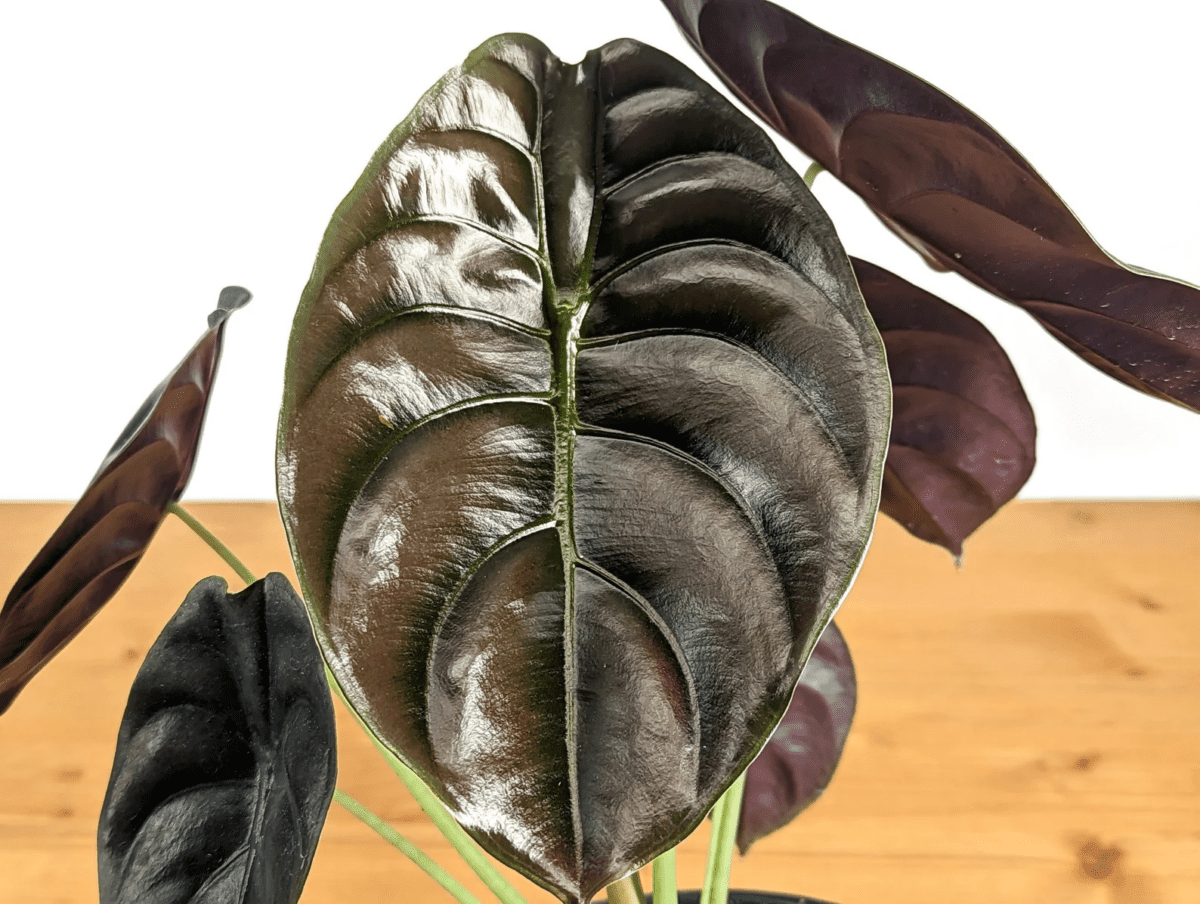
Image via Plantamani
With its deep burgundy red leaves, this plant is stunning! It has intricate leaves with deep ridges and texture and is almost reptilian like!
In nature, this plant grows underneath a tree canopy so has filtered sunlight throughout the daylight hours. This means that you can keep your indoor plant in a place with indirect sunlight and it should grow well.
Since this plant is native to a subtropical region, it prefers quite a bit of humidity. You can achieve this by misting your plant daily or if your house is too dry, you can always get a humidifier. Placing your plant in a bathroom is always a good idea, too!
The ‘Red Secret’ Alocasia will usually never grow taller than 2 feet indoors, so is considered a slow growing plant, but one that can be placed in several spots throughout your home.
8. Alocasia Cucullata ‘Hooded Dwarf’
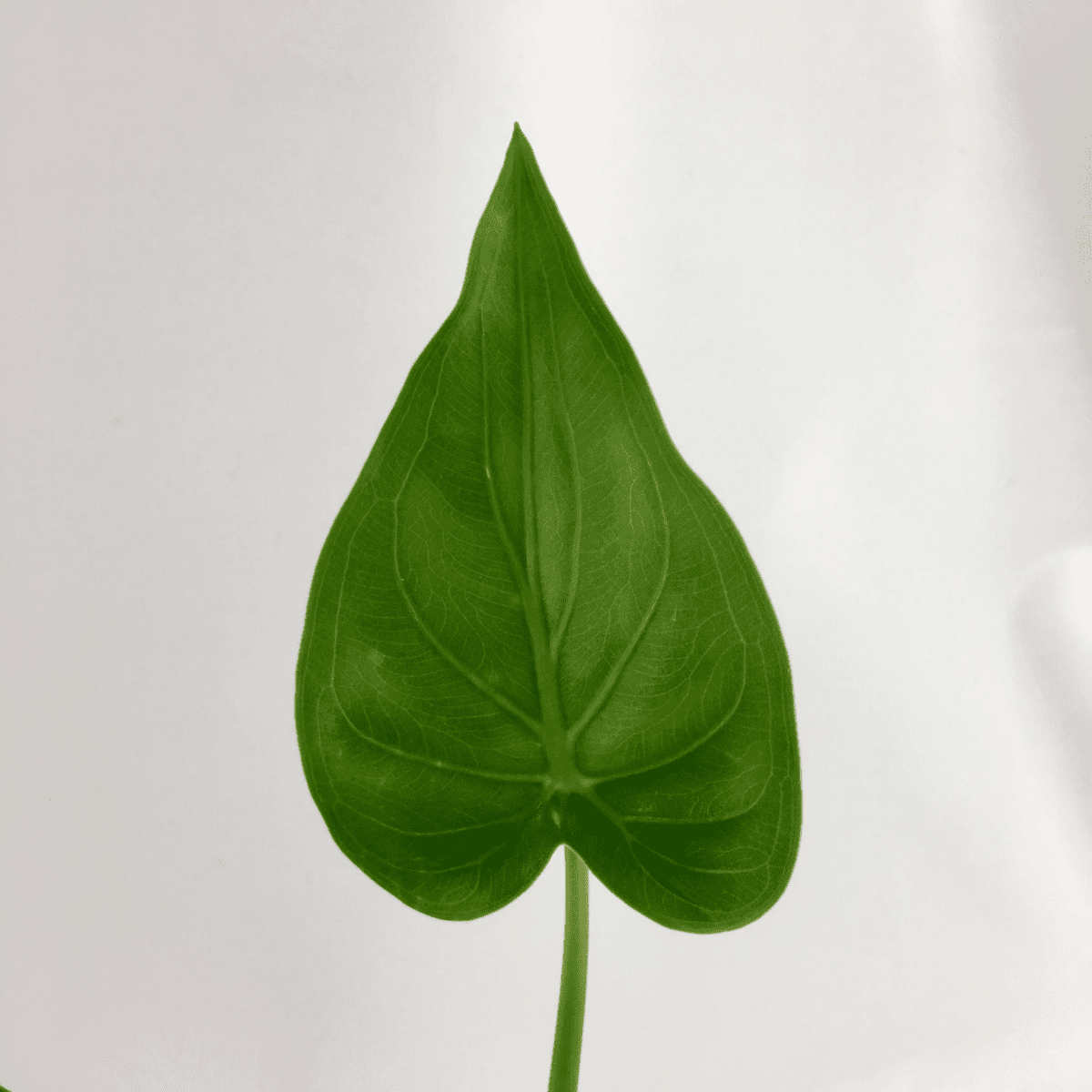
Image via ElementalBonsaiGardn
This has beautiful large, heart shaped leaves with slender stems. It is a popular indoor plant choice. When grown outdoors the leaves seem to be waving at the slightest breeze.
The Cucullata species is smaller than its fellow members which makes it an ideal houseplant choice. It will thrive in bright, well lit conditions, but not in direct sunlight.
This plant is also sometimes referred to as “Buddha’s Palm.” It has also been thought to bring good luck and is often grown in Buddhist temples across Laos and Thailand!
9. Alocasia Longiloba
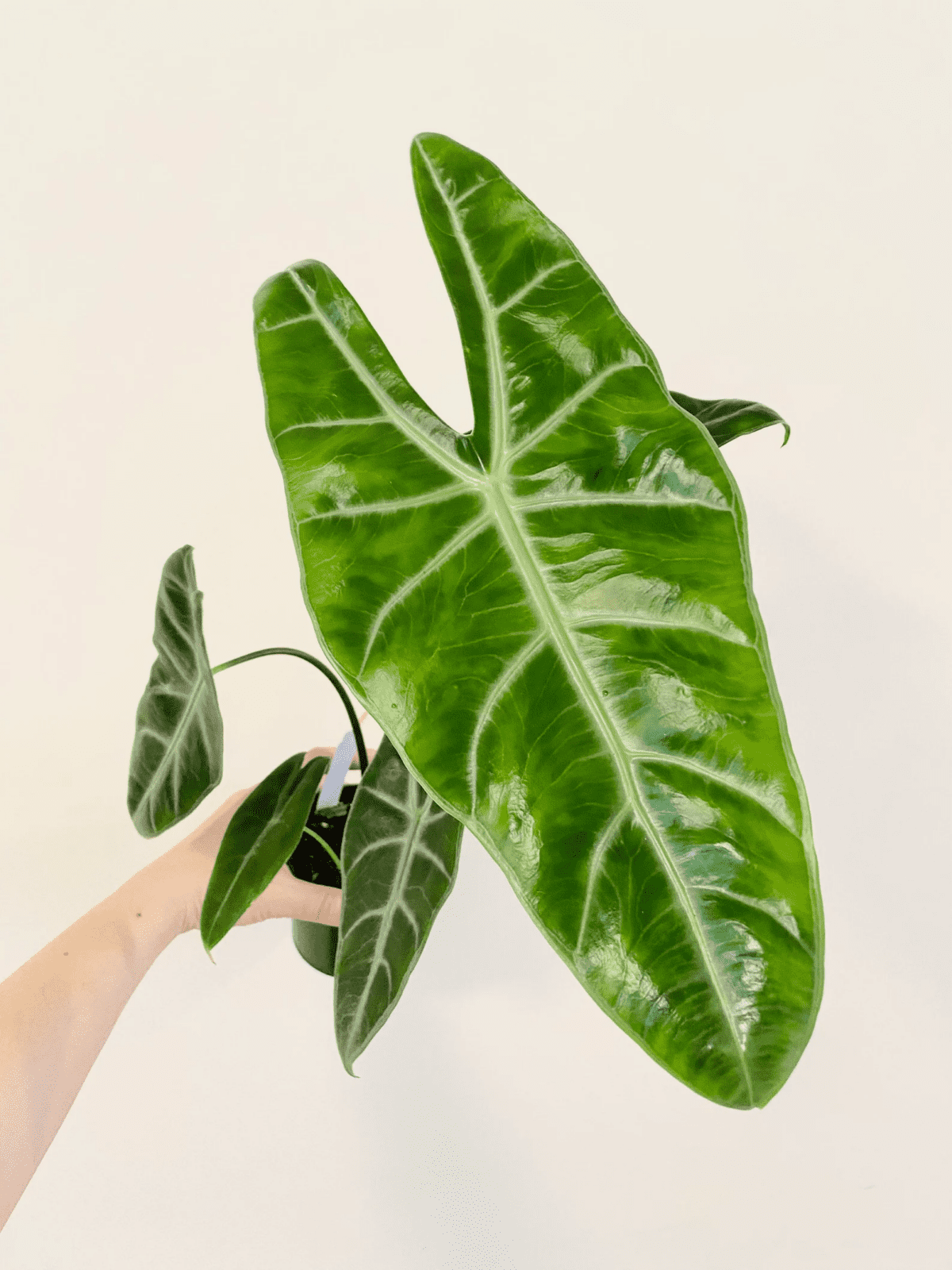
Image via Bronx Plant Lady
This plant has long gray-green leaves with white veining. The name ‘Longiloba’ is from the Latin word “longus” meaning “long” and “lobus” meaning “a rounded projection or protuberance.” Thus, the name!
It wants bright, indirect light. You should avoid placing it in hot midday sun or the leaves will scorch. Also, you should avoid placing your plant in an unheated room or near a cold window.
The Longiloba is prone to certain pests like spider mites, mealybugs, scale, thrips, and whiteflies. These can be prevented with proper care and a regular watering schedule. If you do have a problem with any of these pests, isolate your plant immediately and treat with insecticidal soap until the problem resolves.
10. Alocasia Macrorrhizos ‘Giant Taro’
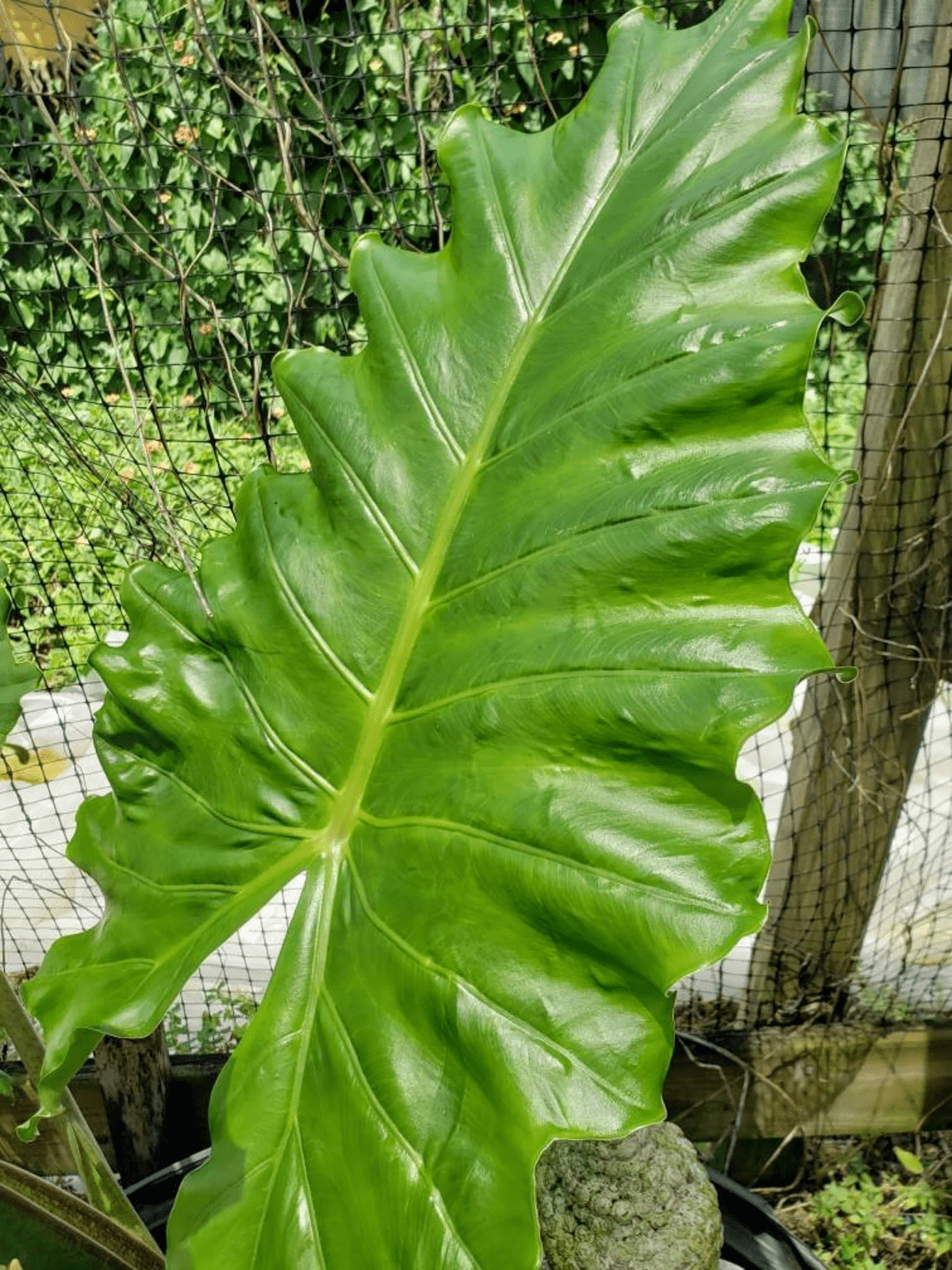
Image via FlutterbyBlessedBee
This is a wonderfully dramatic plant with its giant leaves that resemble the ears of an elephant! It can be grown indoors, providing you have a good location in which to place it.
These elephant ears plants bring a touch of the tropics indoors and give some extra architectural shape to any indoor setting. They are easy to grow and they will give a good show for anyone who enjoys seeing lush foliage in their home!
These grow best in part shade and work well in rooms that are not well lit. They should be kept away from full sun as the leaves will scorch when exposed. Plants require regular watering and fertilization.
11. Alocasia Wentii
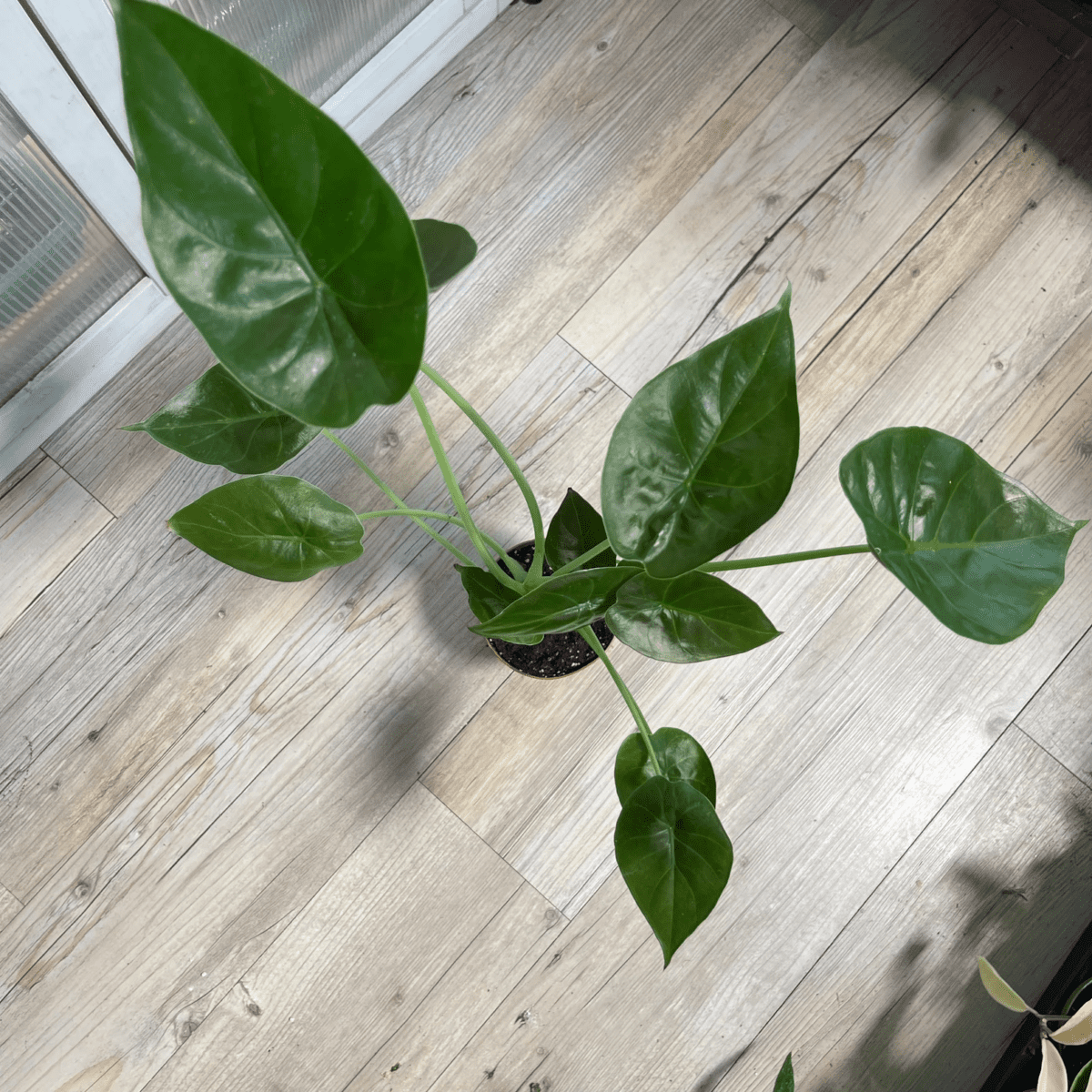
Image via IDY Plants
These beauties are known for the unusual coloring on their leaves. They have green on the front and deep purple on the back side!
They are native to the highlands of New Guinea. It is a popular houseplant, however, which appreciates higher humidity indoors. This would be a perfect plant to have in your bathroom or any room that has high humidity in your home!
Place your Alocasia Wentii in bright, indirect light, but keep it out of direct sunlight. You can also use artificial grow lights if you don’t have natural lighting available in your home. Be sure to keep your Wentii well watered, but don’t overwater to avoid root rot.
12. Alocasia Portei
According to NASA, these plants are excellent air purifying indoor plants. They are known to help absorb formaldehyde coming out of electronics or laptops and it also cleans other harmful toxins from the air.
They are also considered to be extremely eye-catching due to the distinct scalloped edges of the leaves. It prefers warmth and humidity and if it is allowed to get too dry, it is prone to attacks from pests such as red spider mites.
It prefers to be placed in filtered sun or a deep shaded position. These Alocasia Porteis also prefer moist soil, but don’t like wet feet. Therefore, be sure to not let the plant stand in water. Have a well draining pot with soil that drains properly and you should be just fine!
13. Alocasia Odora Variegata
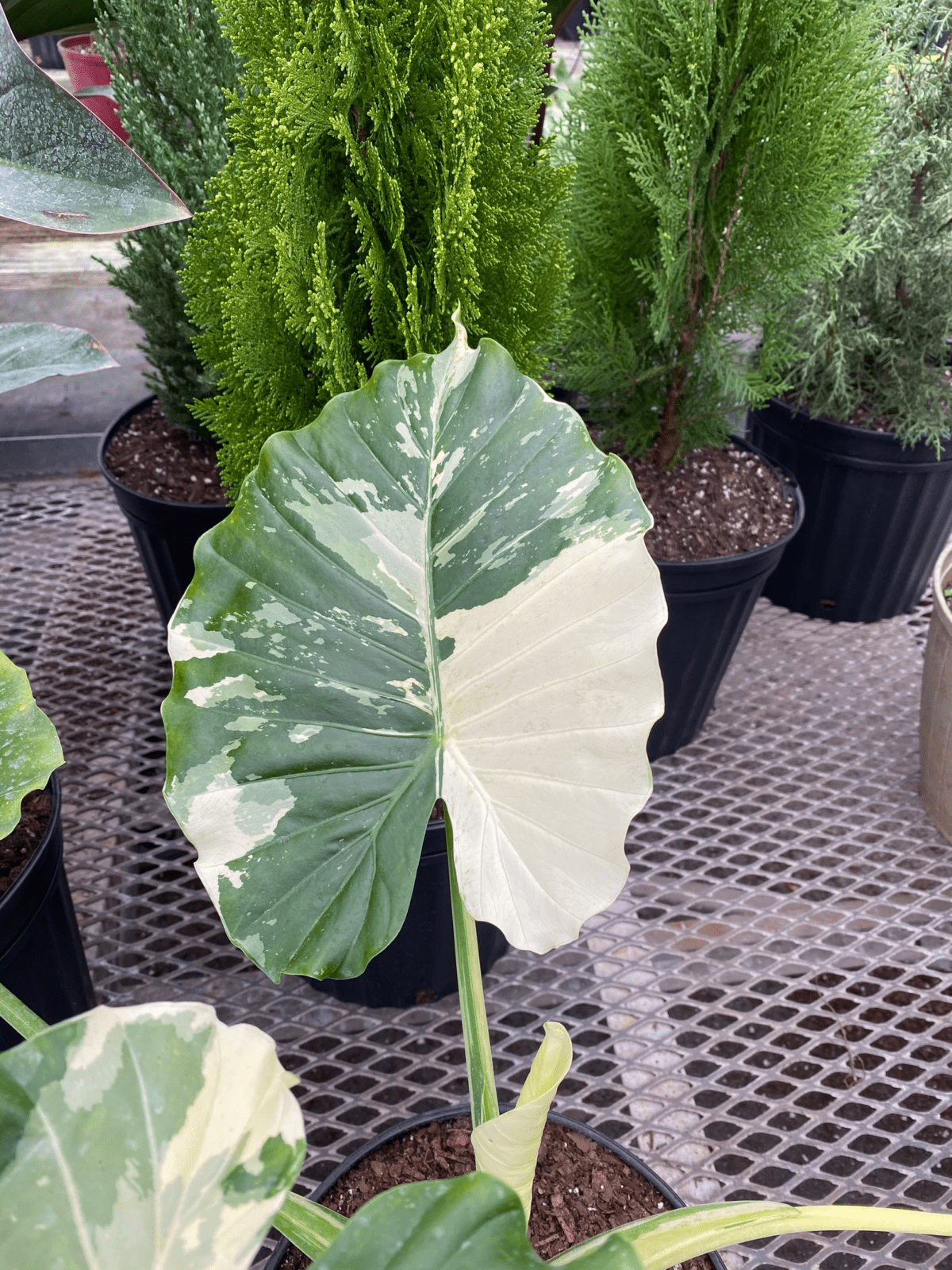
This plant is considered to be very rare due to its variegated white and green leaves. It has a very dramatic look and is often sought after as a prized houseplant for growers.
It is also known that the genetic variegation pattern is highly unstable which means that one leaf can be all green, while others many be all white and another splotched both green and white!
Due to the rarity of these plants, they are often difficult to find and also may cost more than the run of the mill Alocasia. They are difficult to propagate and take longer to grow compared to their non-variegated counterparts.
14. Alocasia Nebula ‘Imperialis’
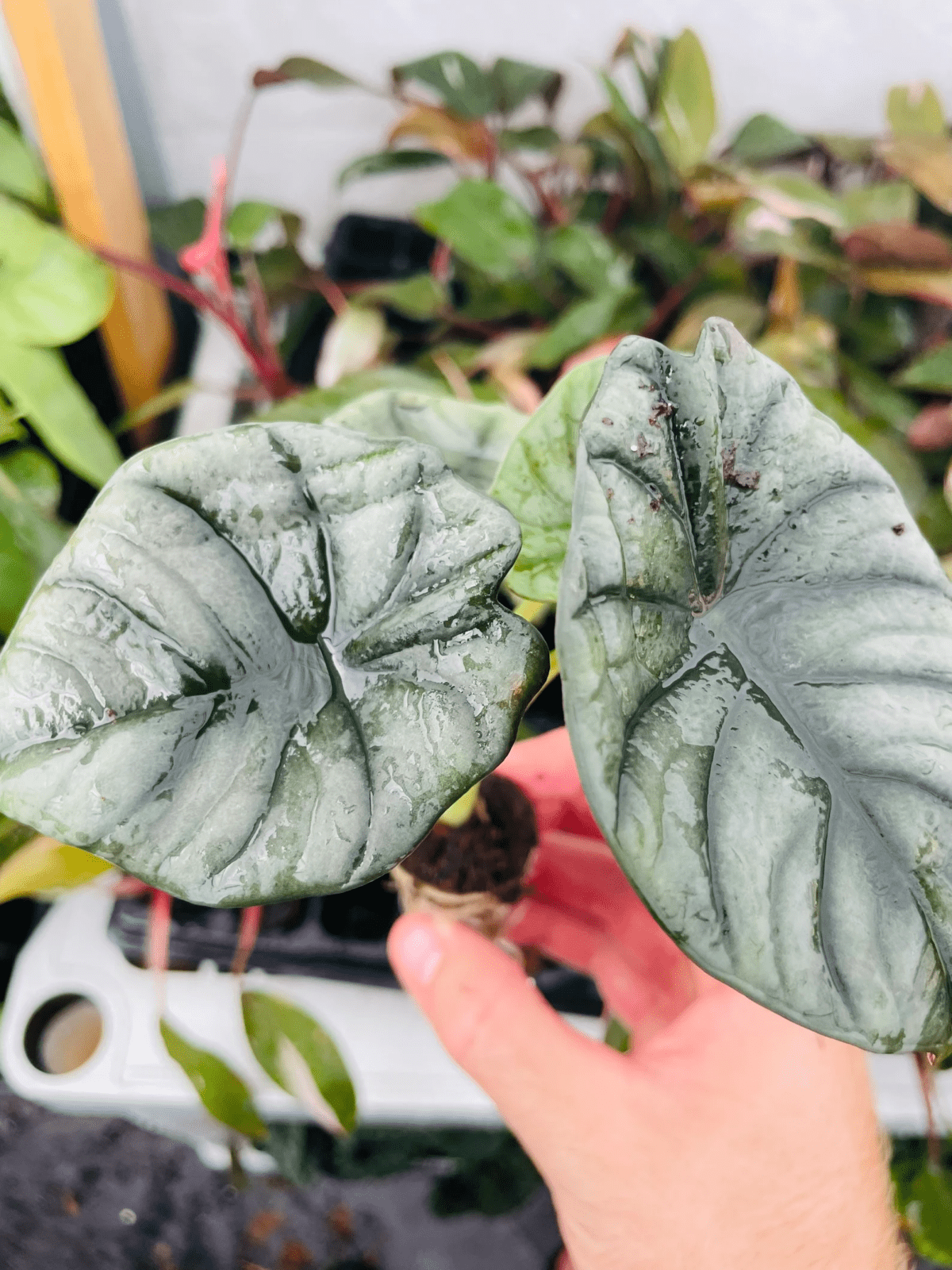
Image via Sunshine Greens
These Alocasia may have difficulty growing and will drop leaves without sufficient sunlight. They should be placed less than three feet from a window to maximize the potential for growth.
This Alocasia will grow fine in a house without additional humidity. You can mist them occasionally, but this is not necessary. They will get the moisture they need from the watering you do.
The Alocasia Nebula ‘Imperialis’ is native to subtropical Asia and Eastern Australia. It is common for them to go dormant in the winter months, so you may notice their growth slow down a bit.
15. Alocasia Plumbae ‘Flying Squid’
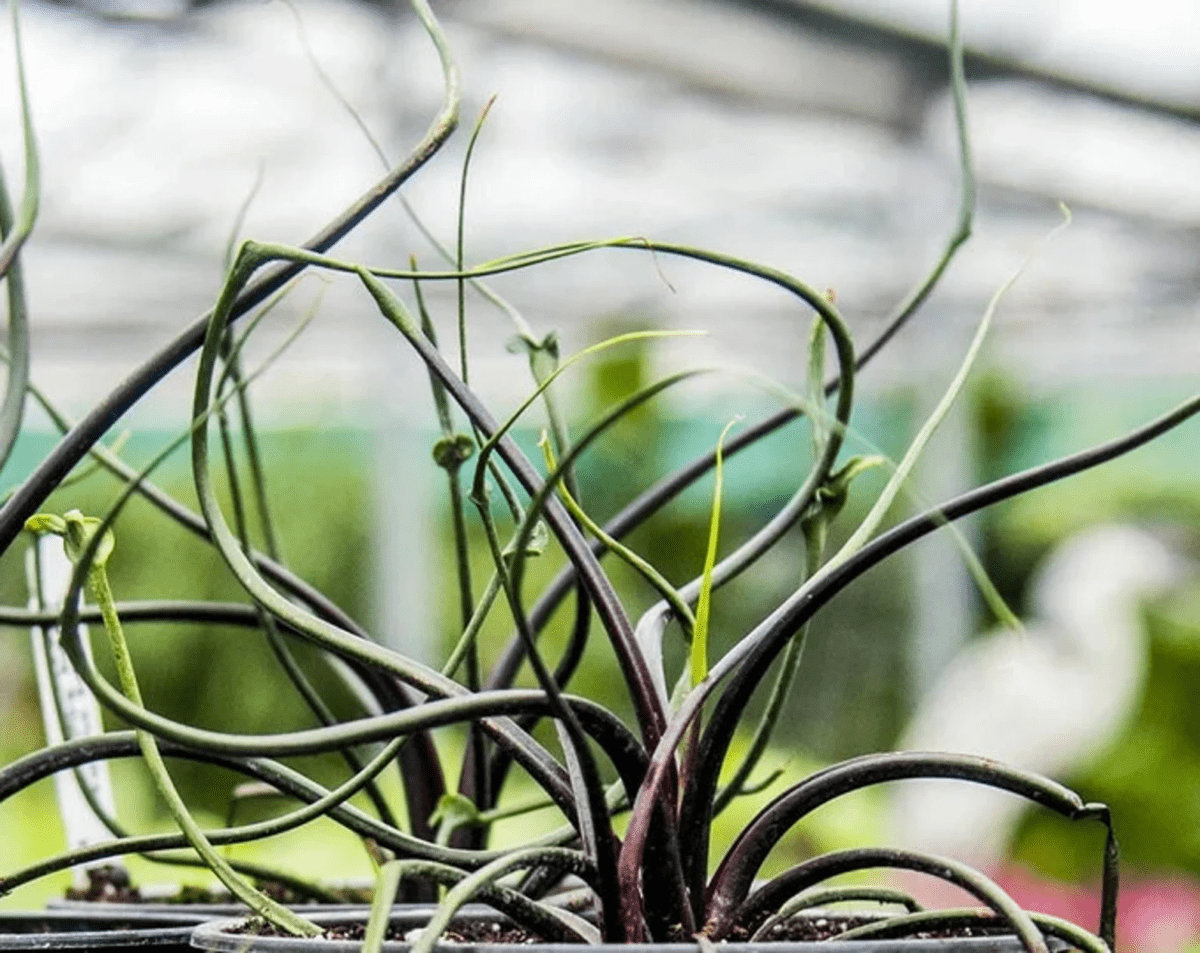
Image via Sunshine Greens
These Alocasia are extremely unique due to their distinct shape. The leaves have a weird “tentacle like” appearance, thus the name ‘Flying Squid!’
These should not be placed in full sun. They do need sufficient light, however, or they will drop their leaves. Placing your plant less than three feet from a south facing window will ensure maximum light and good growth for your plant.
You shouldn’t need to fertilize your ‘Flying Squid’ as most potting soils have sufficient nutrients to produce new growth. By the time your plant has depleted the nutrients in the soil, it has likely grown large enough that it should be placed in a new pot anyway.
16. Alocasia Lauerbachiana ‘Purple Sword’
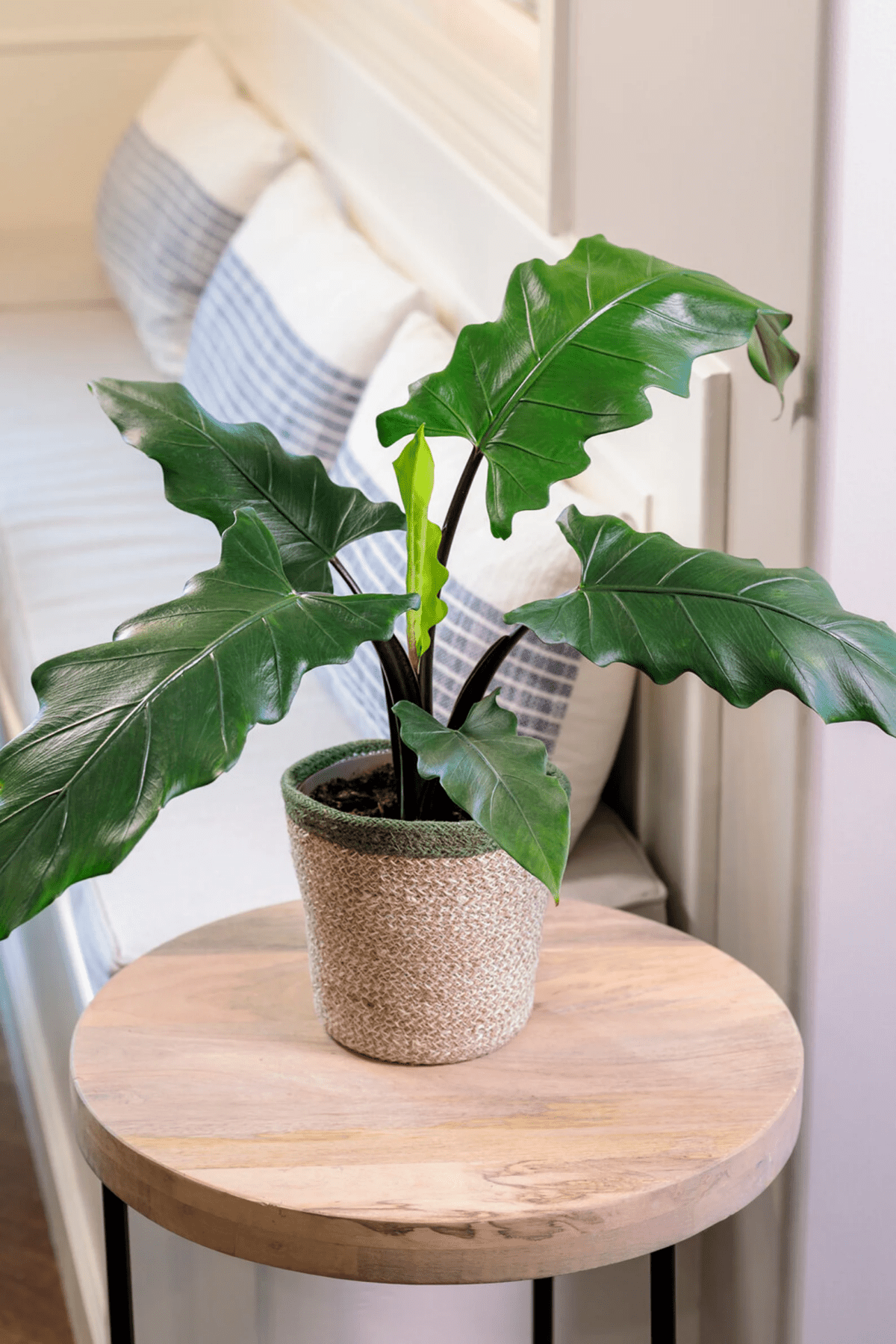
Image via Sunshine Greens
So, now we’re talking about a very unusual textural plant with leaves that are deep green on the topside and light brown on the underside. The leaves are elongated and sword shaped.
The leaves of this plant stand tall and give a lot of architectural interest to any houseplant grouping. This plant does also love any added humidity, so would benefit from misting occasionally.
The soil should be kept consistently moist, but not wet. It needs to have well draining soil. Allow the top inch of the soil to dry out between waterings.
17. Alocasia Baginda ‘Silver Dragon’
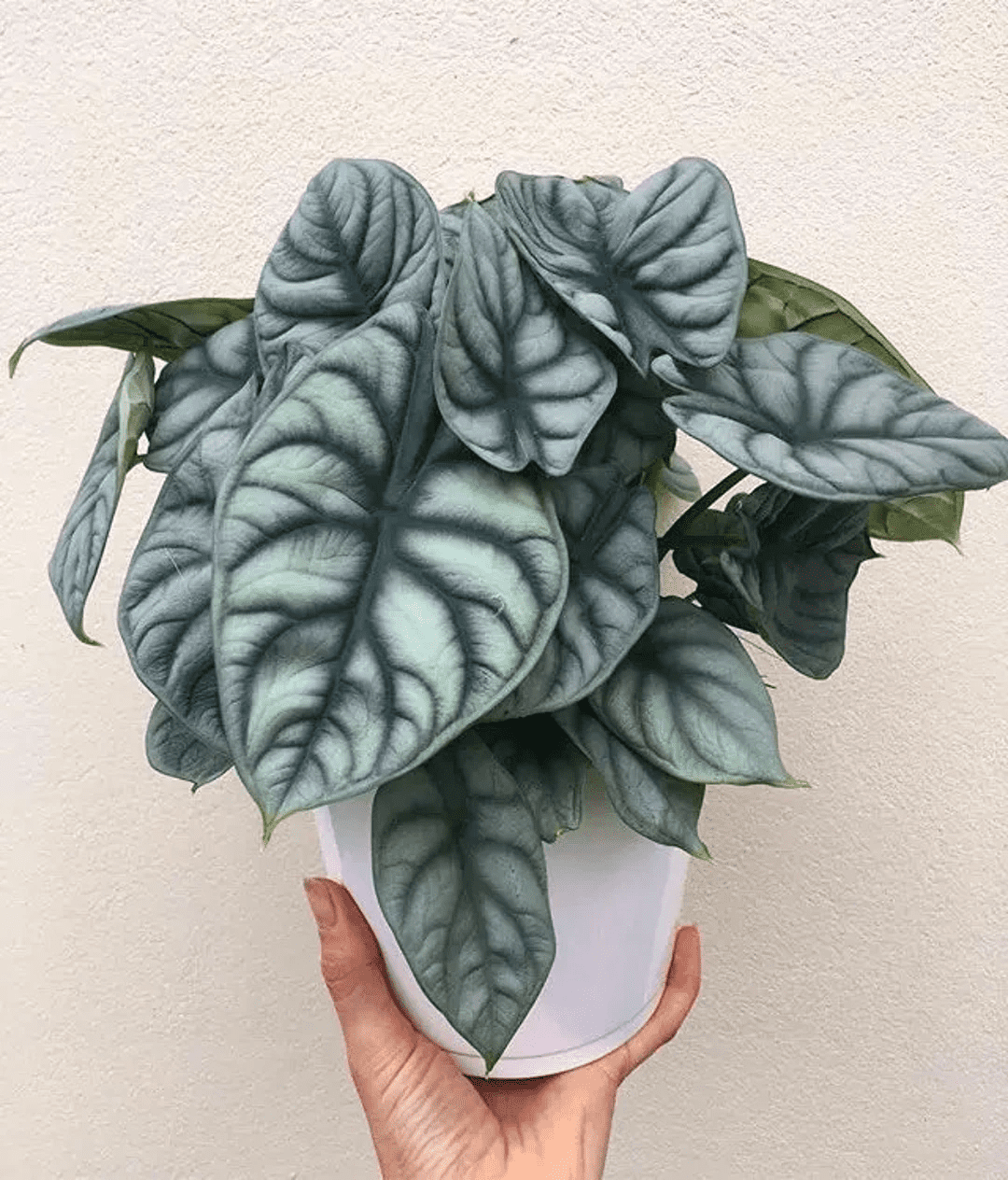
Image via Sunshine Greens
When growing this plant indoors, you will need to be sure to give it the right light conditions and the right warmth and humidity levels. This is not always the best beginner plant, but if you give it the proper care, it will truly be a talking point amongst your guests!
You should keep your plant in a place that has bright, indirect light. Too much exposure to direct sunlight can scorch the leaves, but too much shade will hinder its growth. Rotating your plant will help it grow evenly.
Be sure to keep your ‘Silver Dragon’ away from either hot or cold air vents in your home. These plants need high humidity to survive. Anything above 50% humidity should be fine, but they thrive at humidity levels between 60% and 80%.
18. Alocasia Baginda ‘Dragon Scale’
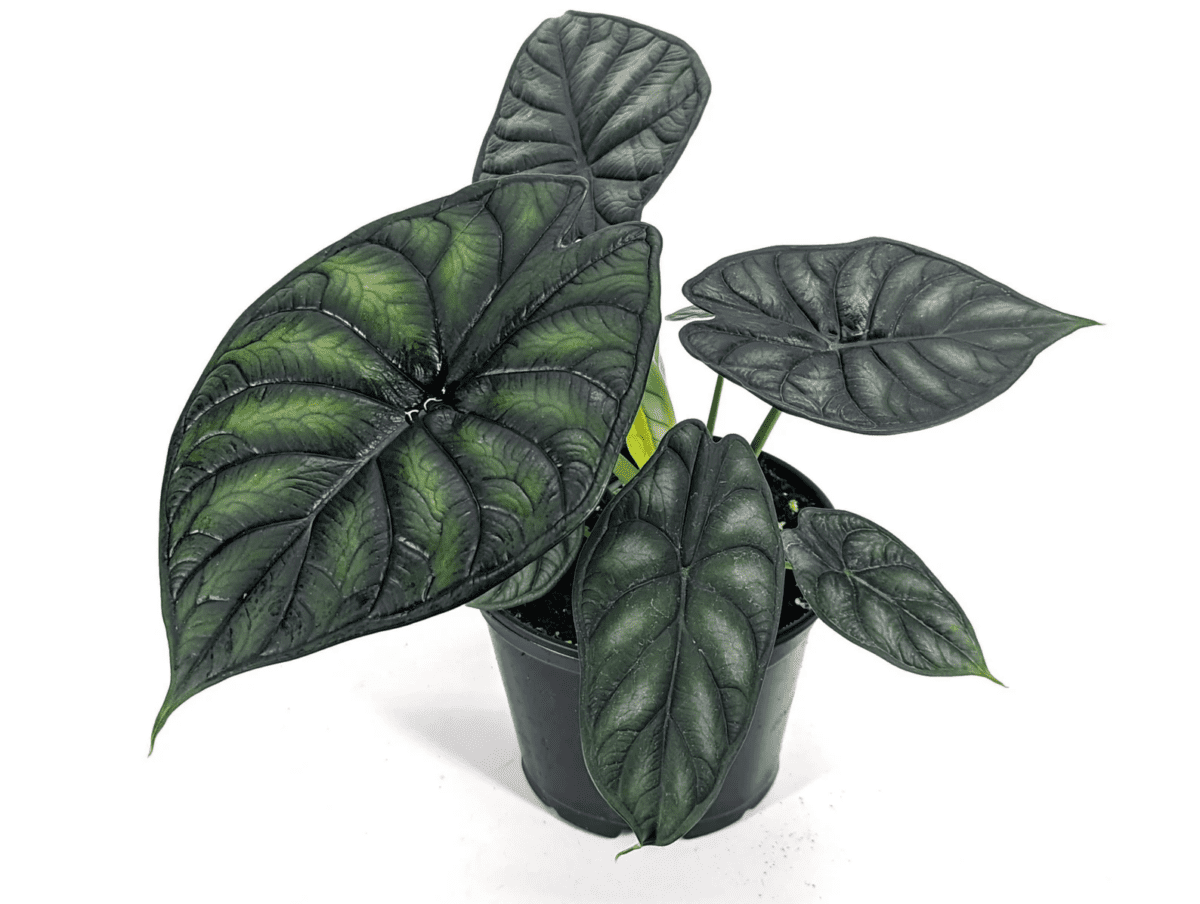
Image via Plantamani
This Alocasia is native to Eastern Borneo where the conditions are hot, humid, and moist. Maintaining humidity levels between 60% and 80% are ideal for this plant.
The foliage on this plant is outstandingly beautiful! It almost looks fake when you see it! Some have compared its textured leaves to being crafted from granite. Maybe even a dragon’s scale!
They thrive in bright, indirect light conditions. The temperature should be kept between 55 and 80 degrees F. Watering this plant is easy as long as you don’t overwater. Water it once the top 2-3 inches of the soil dries out.
19. Alocasia Maharani ‘Grey Dragon’
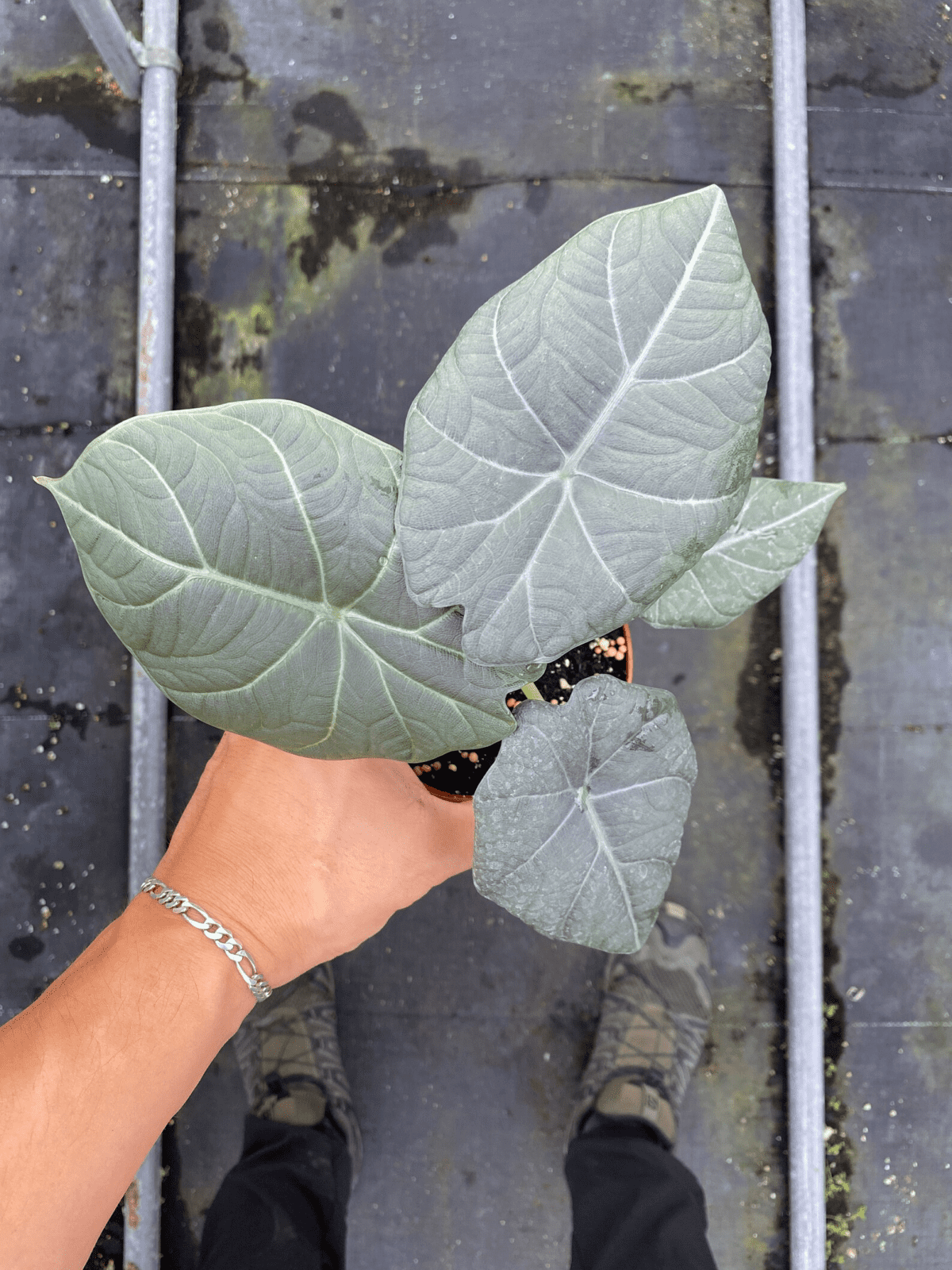
Image via Rooted FL
Some growers consider the ‘Grey Dragon’ an easier variety of the Alocasia to grow than others. However, this plant does need consistent moisture to survive indoors. It is not one to forget to water for a few weeks at a time!
This Alocasia is native to Southeast Asia so is accustomed to warm, humid conditions. In spite of this, the ‘Grey Dragon’ will grow well in average household temperature and humidity levels.
The temperatures should be kept above 59 degrees F when possible.
This particular plant is also known for being small and compact, so does well as an indoor plant. At maturity, it usually tops out at about 14 inches tall.
20. Alocasia Micholitziana ‘Frydek’
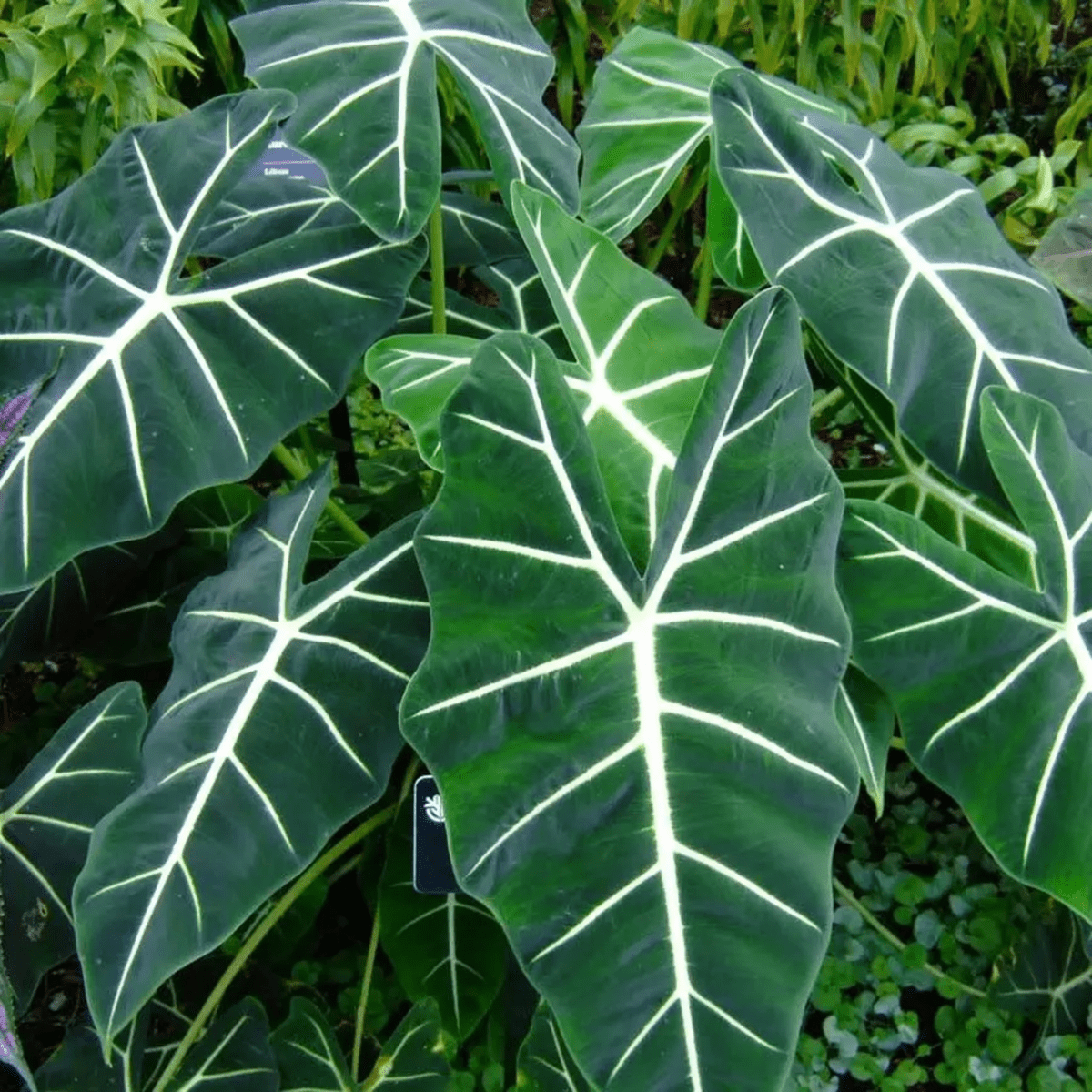
Image via Sunshine Greens
This stunning plant has large, green, arrow shaped leaves with thick white veins. It is also called the Green Velvet Alocasia. It has grown to be quite popular as a houseplant over the last few years.
You should provide bright, indirect light for your plant. It also needs high humidity and a well draining potting mix that will hold moisture. It should be kept in a place where the temperatures range from 65 to 85 degrees F.
Water only when the top 1-2 inches of the soil is dry. You will need to monitor the plant to see how much water it is using, depending on the time of year, rather than watering on a schedule.
21. Alocasia amazonica ‘Polly’
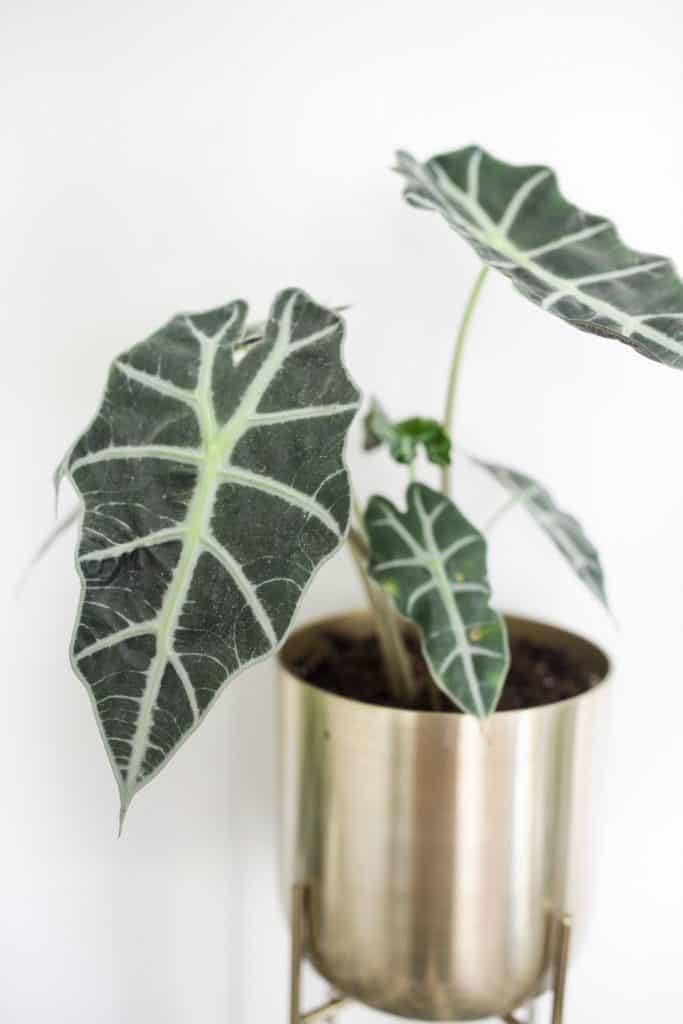
The Alocasia Polly is one of the most common alocasia species out there. The leaves on the polly are ruffled and they have the signature heart shape to them. They’re more glossy with a white vein.
This plant is a great option for indoors since it is compact style of plant. They grow best in indirect light and thrive with a good amount of humidity. Be sure to give this plant around 6 hours of indirect light for optimal growth.
In Conclusion
As you can see, there are a lot of varieties when it comes to the plant world, even in one species. The Alocasia family is one of the most unique families and has a lot to offer as far as appearance, cost, and care of houseplants.
Want to learn about other types of plants? Check out one of these!
